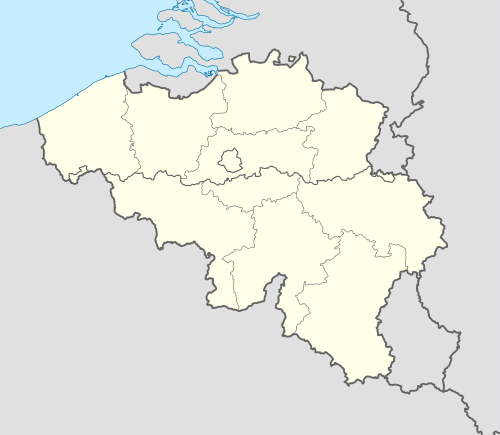Musée Hergé
The Musée Hergé, or Hergé Museum, is a museum in Belgium dedicated to the life and work of the Belgian cartoonist Georges Remi (1907–83), who wrote under the pen name Hergé, creator of the series of comic albums, The Adventures of Tintin.
Musée Hergé | |
.jpg) The walking bridge approach to the Musée Hergé | |
 The Musée Hergé's location within Belgium | |
| Established | 2 June 2009 |
|---|---|
| Location | Rue Labrador 26 1348 Louvain-la-Neuve, Belgium |
| Coordinates | 50.671115°N 4.612809°E |
| Architect | Christian de Portzamparc |
| Website | www |
The museum is located in the town of Louvain-la-Neuve in Wallonia to the south of Brussels at the address, "Rue Labrador 26", Tintin's first home in the books. It was designed by the French architect Christian de Portzamparc,[1] with interiors designed by cartoonist Joost Swarte.[2][3] The first stone was laid May 2007 during the centenary of Hergé's birth[4] and it opened in June 2009.[5] It consists of three floors with a total of nine exhibition rooms, and a café, museum shop and mini cinema.[6]
Museum
Visitors begin at the top floor.[3] The first room is dedicated to Hergé's life. The second room displays Hergé's many interests, his early commercial illustrations, and his early comics. Visitors then cross a long walkway, viewing the lobby on one side and an oak forest outside on the other. The third room introduces the world of Tintin, with nine glass vitrines dedicated to the main characters of the series. The fourth room focuses on Hergé and cinema. Moving down one floor, visitors enter the largest room in the museum, devoted to places in the world Tintin has travelled. Next to this is another large room of Professor Calculus' "laboratory", which focuses on science in the Tintin books. Crossing a lower bridge, visitors learn about Studios Hergé. The final room is called "Hergé Acclaimed", showing Hergé's connections to politicians, artists and philosophers.[3] On the main floor is the space for temporary exhibitions, such as Into Tibet With Tintin.[7] Visitors are offered a three-hour narrated tour of the museum via headphones connected to an iPod.[8] 100,000 visitors arrived during the museum's first year.[9]
During the museum's inauguration, journalists were informed of the museum's policy that no photos are allowed to be taken inside the museum to prevent "copyright abuse due to the work exposed". Disgruntled, some journalists left the museum.[10][11] Journalists were allowed to photograph some parts of the museum when King Albert II toured the museum the following month.[12] Today, the museum is mainly visited by tourists.[10] The museum has been accused of catering to die-hard fans at the expense of other groups.[13]
In October 2013, it was announced that the museum was operating at a loss.[10] Although the museum is entirely private and belongs to the Hergé Foundation which holds rights over Hergé's work,[13] the owner, Nick Rodwell, requested financial assistance from the Belgian government.[10]
See also
References
- "The Hergé Museum by Christian de Portzamparc". Contemporist. 3 June 2009. Archived from the original on 13 December 2013. Retrieved 14 June 2013.
- "Musée Hergé: À propos du musée". Musée Hergé. May 2012. Retrieved 28 April 2013.
- Beaty, Bart (14 June 2009). "Bart Beaty On The Herge Museum". The Comics Reporter. Archived from the original on 29 June 2017. Retrieved 15 January 2015.
- "Le musée Hergé sort de terre" [The Hergé Museum is Out of the Ground]. Le Soir. Brussels. 21 May 2007. Retrieved 15 January 2015.
- "The Hergé museum: Totally Tintin". The Economist. London. 28 May 2009. Retrieved 14 June 2013.
- "Musée Hergé: Museum Layout". Musée Hergé. May 2012. Retrieved 28 April 2013.
- "Musée Hergé Temporary Exhibition: Into Tibet with Tintin". Musée Hergé. May 2012. Archived from the original on 4 June 2012. Retrieved 28 April 2013.
- "Et voici les musées "augmentés"" [And Here are the "Augmented" Museums]. Le Soir. Brussels. 7 February 2012. Retrieved 15 January 2015.
- "Musée Hergé: 100.000 visiteurs pour la première année" [Hergé Museum: 100,000 Visitors in the First Year]. Le Soir. Brussels. 26 May 2009. Retrieved 15 January 2015.
- "Tintin And The Copyright Sharks - Falkvinge on Infopolicy". Falkvinge.net. 24 October 2013. Retrieved 27 May 2014.
- Couvreur, Daniel (26 May 2009). "Hergé a son musée et sa polémique" [Hergé Museum and its Controversy]. Le Soir. Brussels. Retrieved 15 January 2015.
- De Vogelaere, Jean-Philippe (1 July 2009). "Le Musée Hergé se laisse enfin photographier" [Hergé Museum Finally Allowed to be Photographed]. Le Soir. Brussels. Retrieved 15 January 2015.
- De Vogelaere, Jean-Philippe (26 May 2009). "Le journaliste Tintin aurait apprécié" [The reporter Tintin would have appreciated]. Le Soir. Brussels. Retrieved 15 January 2015.
External links
| Wikimedia Commons has media related to Musée Hergé. |